Site menu:

August 2016 Newsletter
Wetland Bird Survey 2014/15 Summary.
Colour Ring Report.
July Bird News.
Forthcoming Events.
Latest Newsletter.
Wetland Bird Survey 2014/15 Summary
Both the National and local, Dee Estuary, Wetland Bird Survey Reports for 2014/15 have been published. As always these give us an insight into how our wetland birds are doing across the country and how the Dee Estuary fits in with national trends.
"Summary Report"
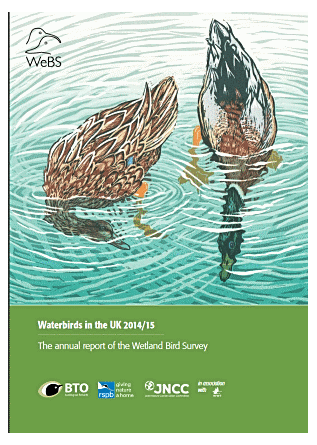 These
days all the UK data is published on-line although I do miss the book
they used to publish with detailed accounts of every species. However,
the on-line summary report for 2014/15 is particularly interesting with
loads of articles which include: "Birds of lakes and ponds", "East
Atlantic Flyway monitoring", "Diving ducks on the rise in
Finland", "Increasing numbers of some scarcer wintering wader species",
"Globe-trotting Godwits" and "Focus on... Crane", as well as several
others including those going into more detail into WeBS
trends. Click on the
image to download a PDF version of the Report. To look at the data
itself click on https://www.bto.org/volunteer-surveys/webs and
follow the link "Search the WeBS Online interface" where you can search
either for Site or Species.
These
days all the UK data is published on-line although I do miss the book
they used to publish with detailed accounts of every species. However,
the on-line summary report for 2014/15 is particularly interesting with
loads of articles which include: "Birds of lakes and ponds", "East
Atlantic Flyway monitoring", "Diving ducks on the rise in
Finland", "Increasing numbers of some scarcer wintering wader species",
"Globe-trotting Godwits" and "Focus on... Crane", as well as several
others including those going into more detail into WeBS
trends. Click on the
image to download a PDF version of the Report. To look at the data
itself click on https://www.bto.org/volunteer-surveys/webs and
follow the link "Search the WeBS Online interface" where you can search
either for Site or Species.
Wildfowl
Remarkably, 14 out of our 16 commoner wildfowl species increased in 2014/15 compared to 2013/14. Does this mean the Dee Estuary had a bumper wildfowl winter? Well, not really, I'm afraid it was more a reflection of the poor winter preceding it. However, there were certainly some highlights including a count of 6,208 Pink-footed Geese on Jan 25th 2015, up from the previous record of 4,000. There was an even higher count in 2015/16 so now the five year average is of International Importance. Brent Geese reached a new high with 270 in January 2015. Shelduck numbers have varied greatly since a high of 12,234 in 2010/11, they reached a low of 4,632 in 2013/14 but there was a welcome increase to 6,947 in 2014/15. The Dee Estuary was the most important site in the country for Shelduck in 2014/15 but both the National and Local trend is of a slow decline. It was good to see a big increase of Wigeon with 5,028 compared to a low of just 1,177 in 2011/12. Numbers over the past three winters have returned to what has been typical for the past 25 years or so.
Waders
Over-wintering numbers were fairly
disappointing, mainly due to the mild weather which means a lot of
birds stayed further east. An exception were
Sanderling with a max of 1,545 on Nov 9th 2014, the third highest
count over the past 35 years. But the highlight was undoubtedly the
large numbers of Dunlin on passage in August with a remarkable 24,232
on the 10th, there have only ever been two higher August counts on the
Dee and
they were both in the early 1970s. The count of 24,232 was the fourth
highest in the country for the whole of 2014/15, the
highest being 44,250 at the nearby Mersey Estuary in December.
Nationally numbers have declined quite substantially since the
mid-1990s although over the past six or seven years they have levelled
off.

http://www.fromthemuddybanksofthedee.com/
References/Sources of Information:
1. Frost T.M. et al. WeBS Report Online: Waterbirds in the UK 2014/15. BTO, RSPB and JNCC in association with WWT. https://www.bto.org/volunteer-surveys/webs.
2. Neil Friswell and Colin E. Wells, Dee Estuary and North Wirral Foreshore: WeBS Annual Report 2014/15.
3. Cheshire and Wirral Bird Reports 1968 to 2014, CAWOS.
Richard Smith.Colour Ring Report
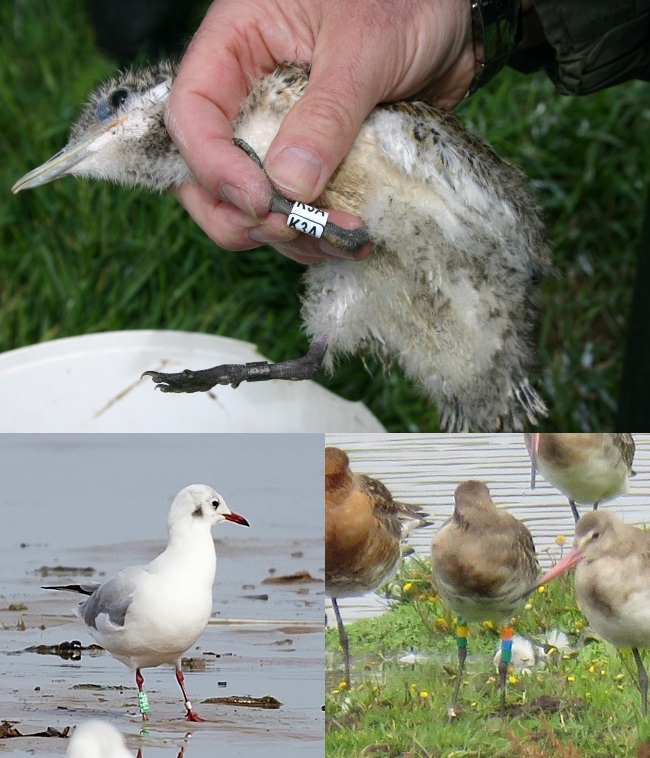
A much better month with several colour-ringed gulls, Black-tailed
Godwits and Sandwich Terns recorded, although only one of the latter
could be read. We are still waiting for feedback for quite a lot of
birds but these are the one's received so far.
Sandwich Tern
The Dee Estuary and North Wirral Shore is one of the most important staging areas in the country for Sandwich Terns post-breeding before they make their way south, but we have little idea where the many hundreds of birds which come here have bred, so it's particularly pleasing to see a colour-ringed bird in order to gain more knowledge about this fascinating species. K3B shows an interesting north-east dispersal across the Irish Sea.K3B
- black letters on a white ring.
Ringed as a chick on June 17th 2016, at Sgarbheen Island,
Ladys Island Lake, Co Wexford, Ireland (Ladys Island Lake is a major
tern nesting site including 1799 pairs of Sandwich Tern - thanks to
Tony Murray for the info).
Recorded at Hoylake Shore on July 23rd 2016.
Also recorded at Ladys Island Lake, Wexford, on July 11th and 12th 2016.
Black-headed Gull
J39E - white letters on green ring. Ringed in Oslo, Norway, on April 14th 2015.Recorded at Hoylake Shore on July 23rd 2016.
Recorded a further seven times in Oslo between the ringing date and May 26th 2015.
Seen on Hoylake Shore in August, September 2015 and January and February 2016.
It returned to Oslo on March 25th 2016 and was reported from there many times up to July 7th 2016.
Herring Gulls
M+B - black on yellow ring. Ringed as a chick in Cardiff on July 2nd 2013.Recorded on Hoylake Shore on July 22nd 2016.
This bird spent a year in the Bristol area between August 2013 and August 2014.
6U8B - black on yellow ring. Ringed at Harewood Whin Landfill site, 3km west of York, on May 1st 2015.
Recorded on Hoylake Shore on July 22nd 2016.
Black-tailed Godwit
OBG-GYG. Ringed by Mike Pratt & Mervyn Miller at Iken on the River Alde, Suffolk, England, on August 27th 2015, as an adult male.Recorded at Gilroy Nature Park, West Kirby, on July 28th to 31st 2016.
This bird likes RSPB Reserves being seen at Hollesley Marsh in Suffolk in October 2015 and January 2016 before moving to Minsmere, Suffolk, until May 3rd 2016. It was on the River Blyth in Suffolk on May 25th, a very late date if it has bred in Iceland this year.
Richard
Smith and Matt Thomas.
Colour-rings were also reported by Steve Williams and the Hilbre Bird
Observatory, Les Hall and Tanny Robinson.
July Bird News
The Little Terns at Gronant continue to
have a very good season. I don't yet have the final numbers but I do
know there was a record number of pairs nesting and that the number of
fledglings is going to be one of the highest ever. There
was an amazing count of 807 Little Terns (adults and fledglings)
counted on the 20th, there was much speculation about where the extra
birds came from and it is interesting that every year we get this peak
around the third week in July. It seems that around the Irish Sea
Gronant is one of the few colonies to have done well and at least some
of these extra adults will have been failed breeders from elsewhere. In
addition, there are also a lot of non-breeding Little Terns in the
population - probably both second year birds and adults taking a year
off - so they could well be those. Little Tern numbers also
notieably increased around Hilbre with 127 on the 23rd.
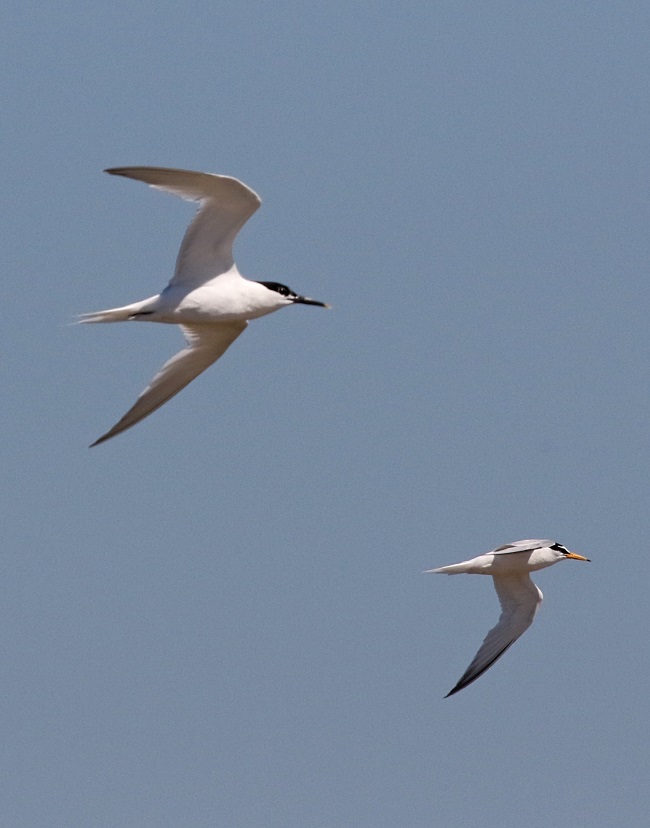
July 23rd saw a count of just over 1,000 Sandwich Terns from Hilbre, and the previous day there were 600 at Hoylake which I counted - it was a nice still day and the noise they were making was amazing! Although the gull roost at Hoylake wasn't anything exceptional in numbers it was good to see several Mediterranean Gulls among them and there were a total of seven individuals along north Wirral.
After last Month's article on the record number of Spoonbills I wasn't expecting numbers to increase yet again, but there were nine on the 28th at Burton Mere Wetlands.
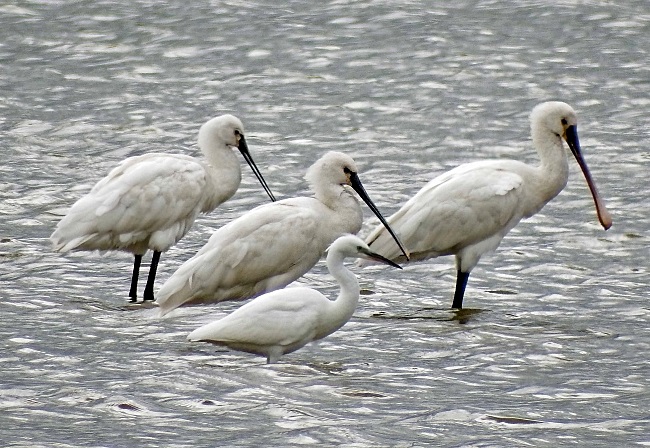
It looks like Spotted Crakes bred at Burton Mere Wetlands again this year with an adult and juvenile first spotted on the 22nd.
By the end of the month the increase in wader numbers was very noticeable and I had 2,500 Dunlin busy feeding off the south end of West Kirby Marine Lake on the 29th. Black-tailed Godwits also increased rapidly over the last week at Gilroy and had reached the all important threshold of Internationally Important Numbers by the 31st, with 630. As usual Heswall was the best place to see Whimbrels with max count of 54 on the 21st. Other good records were seven Common Sandpipers at Connah's Quay on the 4th and two Wood Sandpipers at Burton Mere Wetlands on the 7th.

http://www.fromthemuddybanksofthedee.com/
Richard Smith.
What to expect in August
Given a fresh west wind out to sea look out for Storm Petrels as well as many Gannets and Manx Shearwaters, and given a gale towards the end of the month we can expect Leach's Petrels.
Several Marsh Harriers are usually present and Burton Mere Wetlands is always a good site for them in August, expect also to see returning Hen Harriers. Hobbies and one or two Ospreys should also be spotted.
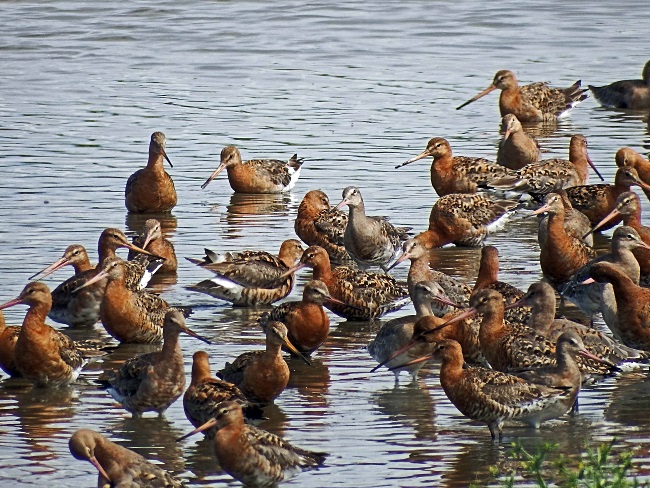
Forthcoming Events
August Highest Spring Tides (Liverpool)
Also
see Tides
page.
20th August, 13.15hrs (BST), 9.5m.
21st August, 13.56hrs (BST), 9.5m.
Forthcoming Events
Organised by the Wirral
Ranger Service , Flintshire
Countryside Service and the
RSPB (Dee Estuary):
All these events and walks have bird interest, even those not
advertised specifically for birdwatching. No need to book for these
events unless specified - please check below.
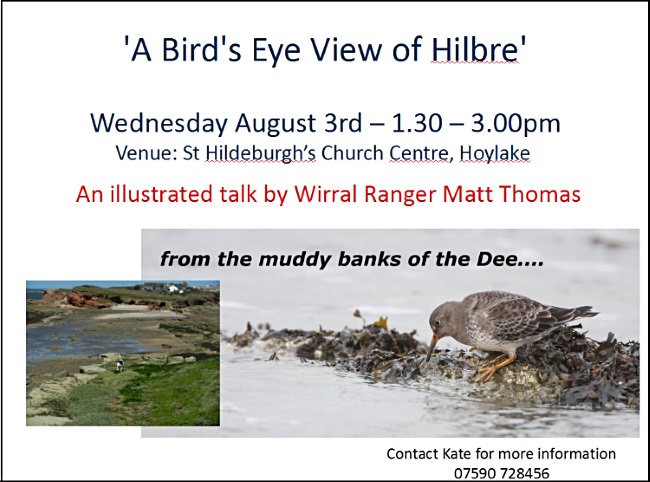
Please note that the entrance for the above Hilbre talk is free but any donations for the Friends of Hilbre will be gratefully received.
FULLY BOOKED! Friday 19th August, Sunset Walk to Hilbre Island.6:00pm to 10:00pm
Join the Rangers and the Friends of Hilbre for a guided walk to Hilbre Island.
On the walk we will learn more about the amazing maritime history of the island and look for the wildlife, including Grey Seals that make the islands their home. There should be large numbers of terns to see flying around the island.
As we return from the island we hope to catch a special Dee estuary sunset.
There is a £3 charge per person with money raised going to conservation work on the islands.
Booking essential: email wcp@wirral.gov.uk or ring 0151 648 4371.
Please wear suitable footwear and bring a waterproof.
Meet by the Dee Lane slipway next to the Marine Lake car park
Saturday 20th August, Hoylake
High Tide Birdwatch.
11 am start, high tide at 1.15 pm, 9.5m.
Free, No need to book.
Join
the Coastal Rangers, the Dee Estuary Voluntary Wardens and the RSPB on
this high tide birdwatch at Hoylake promenade to see large flocks of
wading birds as they gather and roost on the shore. We hope to see
dunlin and knot numbers building as they begin to return from their
breeding grounds, plus a range of other wading birds on migration. With
a rising tide, we should see the birds at close quarters as they roost
and feed.
Beginners welcome - a great opportunity to brush up on
your wader ID with knowledgeable guides. Dress warmly and bring
binoculars if you have them. Telescopes will be available to use
throughout. No need to book.
Meet at the bottom of Trinity Road,
King's Parade, Hoylake. There are public toilets nearby and various
cafes and pubs for refreshments in Hoylake.
For more info ring 0151 648 4371.
